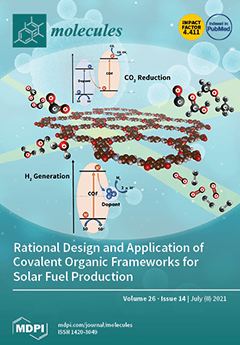In this work, the thermodynamic data basis and equation of state (EOS) modeling necessary to simulate the fractionation of organic liquid products (OLP), a liquid reaction product obtained by thermal catalytic cracking of palm oil at 450 °C, 1.0 atmosphere, with 10% (wt.) Na
2CO
3 as catalyst, in multistage countercurrent absorber/stripping columns using supercritical carbon dioxide (SC-CO
2) as solvent, with Aspen-HYSYS was systematically investigated. The chemical composition of OLP was used to predict the density (ρ), boiling temperature (T
b), critical temperature (T
c), critical pressure (P
c), critical volume (V
c), and acentric factor (ω) of all the compounds present in OLP by applying the group contribution methods of Marrero-Gani, Han-Peng, Marrero-Pardillo, Constantinou-Gani, Joback and Reid, and Vetere. The RK-Aspen EOS used as thermodynamic fluid package, applied to correlate the experimental phase equilibrium data of binary systems OLP-
i/CO
2 available in the literature. The group contribution methods selected based on the lowest relative average deviation by computing T
b, T
c, P
c, V
c, and ω. For
n-alkanes, the method of Marrero-Gani selected for the prediction of T
c, P
c and V
c, and that of Han-Peng for ω. For alkenes, the method of Marrero-Gani selected for the prediction of T
b and T
c, Marrero-Pardillo for P
c and V
c, and Han-Peng for ω. For unsubstituted cyclic hydrocarbons, the method of Constantinou-Gani selected for the prediction of T
b, Marrero-Gani for T
c, Joback for P
c and V
c, and the undirected method of Vetere for ω. For substituted cyclic hydrocarbons, the method of Constantinou-Gani selected for the prediction of T
b and P
c, Marrero-Gani for T
c and V
c, and the undirected method of Vetere for ω. For aromatic hydrocarbon, the method of Joback selected for the prediction of T
b, Constantinou-Gani for T
c and V
c, Marrero-Gani for P
c, and the undirected method of Vetere for ω. The regressions show that RK-Aspen EOS was able to describe the experimental phase equilibrium data for all the binary pairs undecane-CO
2, tetradecane-CO
2, pentadecane-CO
2, hexadecane-CO
2, octadecane-CO
2, palmitic acid-CO
2, and oleic acid-CO
2, showing average absolute deviation for the liquid phase (
) between 0.8% and 1.25% and average absolute deviation for the gaseous phase (
) between 0.01% to 0.66%.
Full article






